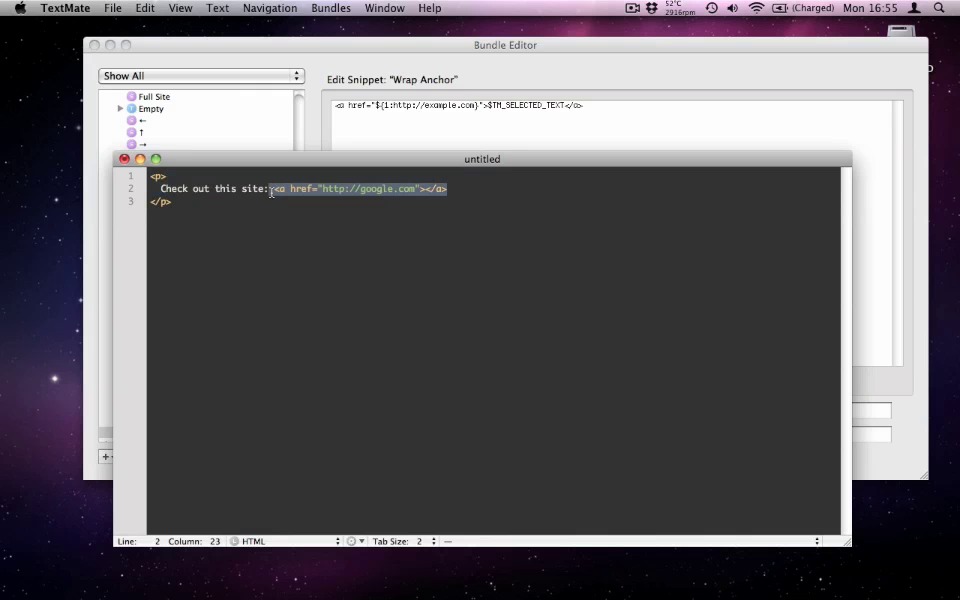

Menu > Text > Convert > Spaces to Tabs Tabs to Spaces If you want to navigate through your project files. If you're working with Node, select "Jump To Symbol" and a window will appear with the names of the functions or methods available. Move your cursor to the specified line number. You can also add regular expressions to your search.

Search for text within any project using shift + command + f. So without further adieu, here are some excellent tricks you can try within Textmate.
Textmate command line android#
Many people also ask me, have you tried IntelliJ IDEA, Android Studio, Webstorm, P圜harm, Eclipse, xCode, RubyMine, Aptana, and the answer is YES! I've tried them all and the reason why I still choose TextMate is because it's lightweight, macro customizable, and flexible enough for me to quickly work on Ruby on Rails, NodeJS, jQuery, Apache Config, PHP, and even Swift. Considering that all of these editors pretty much offer the same (Syntax Highlighting, Support for Multiple Languages, and Auto Completion), the only thing that matters is that I've picked one and am sticking to it.
Textmate command line code#
Hopefully you’ll be inspired to modify and extend the examples for your own use.I've tried Sublime Text, Atom and Microsoft's Visual Studio Code but I still love TextMate 2. If so we can exit, otherwise we retrieve the content of the second line returned by the dialog, assign this to $r and place it into our sed command. On line 6, we perform a check to see whether the ‘Cancel’ button was clicked (button number 2). The dialog will return two lines of text: ] & exit_discardĪ CocoaDialog input box is called and we create two buttons, ‘Cancel’ and ‘Okay’, along with some assistive text. R=$(CocoaDialog inputbox -title "String to be appended to EOL" Adding simple UI elementsĪs a final example, we can extend this command further by introducing a dialog box which prompts for the input of the string to be appended, rather than relying on the clipboard.Ĭreate a new command under the Text bundle with the same input and output settings as above, enter the following as the command: We can also bind this command to a keyboard shortcut if we so wish. The command can be run by going to ‘Bundles > Text > Name of command’.

The input is ‘Selected Text’ or ‘Nothing’ and the output is ‘Replace Selected Text’. If the clipboard contains no more than one line, its contents are assigned to $r and placed into the sed command. The second line of our new command checks whether we have more than one line of data in the clipboard, if so we’ll default to simply appending a comma to the end of the selected lines (line 5). Under ‘Bundles > Bundle Editor > Show Bundle Editor’ we create a new command within the Text bundle. We can also extend the original sed command by taking the content of the clipboard and appending this to the end of each selected line. Rather than having to use the ‘Filter Through Command’ feature each time, we can replicate its behaviour in a stored command. Textmate’s strength however lies in its bundles essentially containers for re-usable blocks of code, templates and snippets. The comma can of course be replaced with any string. We now end up with a comma at the end of each line of the selected text. This will allow us to send input data from Textmate to a command and then return the command’s output to the current document. Textmate’s ‘Filter Through Command…’ (under Text) is our first port of call. There are a whole host of available commands and bundles, but what if you need to extend existing ones or create your own? I’ll cover some of the basics which will help you get started…įor this example, I’m going to perform a simple append to end-of-line (EOL) operation on selected text using sed. However, a quick look under the hood reveals how its relationship with UNIX command line tools has allowed it to become a supremely powerful editor. At first glance, Textmate can appear to be nothing more than a bog-standard code editor, lacking the more advanced features of an IDE.


 0 kommentar(er)
0 kommentar(er)
